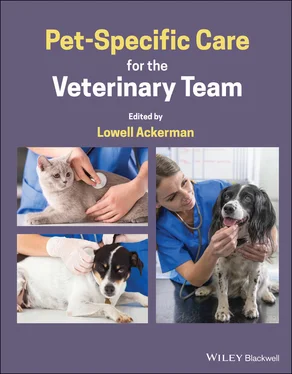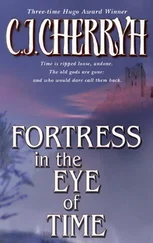To that end, veterinarians should encourage the use of health screening in all their clients. For the clients, screening plays a role in managing the health of an individual pet and developing a holistic, long‐range health plan based upon knowledge of susceptibility to certain diseases. Adverse reactions can be avoided or preemptive care can be initiated if known disease risk is identified through screening. Additionally, screening is an important tool for the health of all companion animals in reducing the incidence of disease and discovery of trends of emerging diseases.
3.7.4 Genetic Health Registries
Many owners and veterinarians wonder if a particular medical issue observed in a companion animal is genetically controlled and related to its breed, sex, growth rate and size, age, or diet. Health registries can help answer those questions. In their simplest form, genetic health registries are repositories of the results obtained from either phenotypic or genetic health screening tests (see 3.4Predicting and Eliminating Disease Traits). By recording and compiling the information in an accessible formant, owners, breeders, and veterinary practitioners can use that to inform decisions. Genetic health registries provide an important resource for the veterinary community by cataloging diseases of a population of animals ( Table 3.7.1), permitting the development of informed treatment plans, and illuminating trends of emerging diseases.
Table 3.7.1 The top 11 breeds with the highest prevalence of elbow dysplasia by breed for those breeds with at least 50 evaluations from 1974 thru 2018
Source: Data from the OFA Canine Health Information Center health registry ( www.ofa.org).
| Breed |
Rank |
Number of evaluations |
% Normal |
% Overall dysplastic |
% Grade 1 dysplasia |
% Grade 2 dysplasia |
% Grade 3 dysplasia |
| Chow chow |
1 |
1248 |
50 |
49 |
25 |
17 |
6 |
| Pug |
2 |
216 |
59 |
41 |
26 |
13 |
2 |
| Rottweiler |
3 |
20 177 |
61 |
39 |
30 |
8 |
1 |
| Bulldog |
4 |
497 |
62 |
37 |
25 |
10 |
1 |
| Fila Brasileiro |
5 |
220 |
68 |
32 |
19 |
10 |
3 |
| Boerboel |
6 |
246 |
70 |
30 |
17 |
8 |
5 |
| Black Russian terrier |
7 |
767 |
72 |
27 |
19 |
7 |
1 |
| Bernese mountain dog |
8 |
17 869 |
73 |
27 |
18 |
7 |
3 |
| Otterhound |
9 |
137 |
73 |
27 |
22 |
4 |
1 |
| Chinese shar‐pei |
10 |
852 |
74 |
25 |
14 |
9 |
3 |
| Newfoundland |
11 |
8394 |
76 |
24 |
15 |
5 |
3 |
A primary objective of a registry is to provide a resource for breeders seeking health information on potential sires or dams. Another objective is to enable prospective owners to research the health of a breed in general or the parents and their relatives of a particular companion pet being considered. For example, Table 3.7.2presents the health information of a dog of interest. In this example, for each dog, its registration number, birth date, and sex are listed followed by any health tests recorded. This particular dog has passed all its health clearances, as have a majority of its relatives. Health registries have the greatest value with broad participation; vast amounts of data provide the necessary power to predict outcomes and analyze trends.
Table 3.7.2 Health information on a dog of interest along with that of its sire, dam, and half siblings
Source: Data from www.ofa.org.
| Dog of interest |
Registration |
Birthdate |
Sex |
Relation |
Hips a |
Elbow b |
Eyes c |
Thyroid d |
| Larentia di Villa Roma |
DN09589103 |
Dec 16 2004 |
F |
Self |
BT‐4753G27 |
BT‐EL2046F27 |
BT‐EYE316 |
BT‐TH315/27 |
| Sire/Dam |
|
|
|
|
|
|
|
|
| Neartic de la Grande Lande |
DL75874001 |
Mar 13 1997 |
M |
Sire |
BT‐3264G32 |
BT‐EL754M32 |
BT‐2233 |
|
| High Clearings Zohra |
DL87843301 |
Apr 5 2000 |
F |
Dam |
BT‐3953G36 |
BT‐EL1321F36 |
BT‐2881 |
|
| Full sibling |
|
|
|
|
|
|
|
|
| Luna di Villa Roma |
DN09589105 |
Dec 16 2004 |
F |
Full Sib |
BT‐4697G24 |
BT‐EL1998F24 |
BT‐3343 |
BT‐TH299/24 |
| Longsword di Villa Roma |
DN09589104 |
Dec 16 2004 |
F |
Full Sib |
BT‐5090E48 |
BT‐EL2362F48 |
BT‐3775 |
|
| Half sibling (sire) |
|
|
|
|
|
|
|
|
| Touchstone's Jaiden D'Shea |
DL76335705 |
Oct 15 1998 |
F |
Half(Sire) |
BT‐3650E37 |
BT‐EL1059F37 |
BT‐2591 |
|
| Touchstone's Jericho Dune |
DL76335702 |
Oct 15 1998 |
M |
Half(Sire) |
BT‐3659G37 |
BT‐EL1068M37 |
BT‐2590 |
|
| Touchstone’s Crown Jewel |
DL76335701 |
Oct 15 1998 |
F |
Half(Sire) |
BT‐3806E45 |
BT‐EL1199F45 |
BSD‐1372 |
|
| Half sibling (dam) |
|
|
|
|
|
|
|
|
| Hufflepuff di Villa Roma |
DN05032106 |
Oct 7 2003 |
F |
Half(Dam) |
BT‐4460E24 |
BT‐EL1781F24 |
BT‐EYE445 |
BT‐TH485/73 |
| House Elf di Villa Roma |
DN05032105 |
Oct 7 2003 |
M |
Half(Dam) |
BT‐5215G71 |
BT‐EL2476M71 |
BT‐3162 |
BT‐TH488/73 |
| Humberto di Villa Roma |
DN05032104 |
Oct 7 2003 |
M |
Half(Dam) |
BT‐4486E25 |
BT‐EL1805M25 |
BT‐3046 |
|
| Hocus Pocus di Villa Roma |
DN05032103 |
Oct 7 2003 |
F |
Half(Dam) |
BT‐4524G28 |
BT‐EL1833F28 |
BT‐3544 |
|
| Hagrid di Villa Roma |
DN05032101 |
Oct 7 2003 |
M |
Half(Dam) |
BT‐4916F49 |
BT‐EL2190M49 |
BT‐3163 |
|
| Hex di Villa Roma |
DN05032107 |
Oct 7 2003 |
F |
Half(Dam) |
|
|
BT‐3047 |
|
| Hermione di Villa Roma |
DN05032102 |
Oct 7 2003 |
F |
Half(Dam) |
BT‐4487G25 |
|
BT‐3044 |
|
| Sidekicks Masters di Villa Roma |
DN15480007 |
Aug 16 2006 |
M |
Half(Dam) |
BT‐5032G24 |
BT‐EL2301M24 |
BT‐EYE73 |
BT‐TH362/13 |
| Sidekicks Mia di Villa Roma |
DN15480003 |
Aug 16 2006 |
F |
Half(Dam) |
BT‐5103E29 |
BT‐EL2375F29 |
BT‐EYE101 |
BT‐TH444/29 |
| Sidekicks Memory di Villa Roma |
DN15480004 |
Aug 16 2006 |
M |
Half(Dam) |
BT‐5062G26 |
BT‐EL2332M26 |
BT‐4096 |
BT‐TH431/26 |
| Sidekick's Morgan di Villa Roma |
DN15480002 |
Aug 16 2006 |
F |
Half(Dam) |
BT‐5056G26 |
BT‐EL2327F26 |
|
|
| Sidekicks Marquise Villa Roma |
DN15480005 |
Aug 16 2006 |
M |
Half(Dam) |
BT‐5093G28 |
BT‐EL2365M28 |
|
|
| Sidekicks Marinos Villa Roma |
1 096 588 |
Aug 16 2006 |
M |
Half(Dam) |
BT‐5122G29 |
BT‐EL2393M29 |
|
|
| Sidekicks Newsflash |
DN21567304 |
May 5 2008 |
F |
Half(Dam) |
BT‐5437E30 |
BT‐EL2673F30 |
BT‐3959 |
BT‐TH600/39 |
| Sidekicks Never Say Never |
DN21567301 |
May 5 2008 |
F |
Half(Dam) |
BT‐5527G37 |
BT‐EL2762F37 |
BT‐3983 |
|
aA hip result is a two‐letter breed code followed by the evaluation number, a subjective code for the hip conformation (E = excellent; G = good; F = fair), and the age of the dog in months when the hips were evaluated.
Читать дальше












